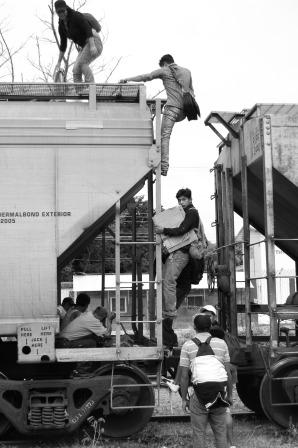
All photos (c) 2012 by Joseph Sorrentino
It’s estimated that between 400,000 and 500,000 migrants travel through Mexico every year. Most of them come from Guatemala, Honduras, and El Salvador; a few from Nicaragua. Some will look for work in Mexico, but the overwhelming majority dream of making it to the United States. On a recent trip to Mexico, I spent some time with two groups that aid Central American migrants traveling through the country. Two things struck me during my time with them: how horrific the migrants’ trip is and how desperate they are.
Hermanos en el Camino (“Brothers on the Road”) is one of about fifty shelters for migrants in Mexico. It was founded by Fr. Alejandro Solalinde in Ixtepec, a small city in the southern state of Oaxaca. Padre Alejandro had worked with migrants in both the United States and Mexico for several years before deciding to settle in Ixtepec (see "A Holy Nuisance"). “I saw the migrants in Ixtepec as sheep without a shepherd,” he said. “No one paid attention to them, no one was concerned with them. They were assaulted.... I said to myself, ‘I must make them my concern.’”
Padre Alejandro chose Ixtepec because it’s an important railroad center and the majority of migrants on their way to the north ride trains. For them, “riding” the trains means sitting on top of cars, or between them. The trains stop in Ixtepec to change or add engines, and that’s when migrants climb on or off. My first night at the shelter I asked a young man next to me whether he had arrived by train. “Si,” he replied. “El tren de los desconocidos”—the train of the unknowns.
Each month about 750 people stay at Hermanos en el Camino, which offers little in the way of creature comforts. There are two dorms—one for men and one for women—but it gets so hot that many people decide to sleep outside the dorms instead. In January and February a strong nightly wind kicks up dust and grit. The showers are cold, the meals simple, but while the shelter may lack amenities, it does give people a safe place to rest before they continue their journey on the train they call La Bestia (“The Beast”). It’s aptly named.
Migrants face many dangers as they head north. Manuel, my Guatemalan roommate at Hermanos en el Camino, was recuperating from injuries he suffered after he fell asleep on top of a train car. He fell off as the train crossed a small river a short distance from the shelter. He lay on the river bank with a broken arm, a broken hip, and a gash in his leg that would require thirty-four stitches. He screamed for eight hours before someone found him.
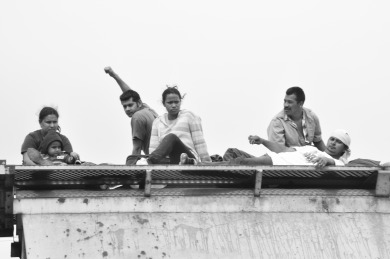
Leopoldo, from El Salvador, was robbed of all his money by men dressed in Mexican police uniforms. “We had to walk, walk, walk, without any money” to reach the shelter, he said. José and María, who are also from El Salvador, approached me during my first full day at the shelter. José did the talking while María just stared at me. She looked haunted, or maybe hunted. When I looked back at her, her eyes darted away. It was clear they were seeking help, but I wasn’t sure exactly what they wanted. I asked Michael, a Guatemalan fluent in English, to be my translator. They told him they had been attacked just after crossing into Mexico. They were robbed, and María was raped. They were hoping I could give them money to help them cross into the United States. I couldn’t. They said they understood, but they had to continue their trip anyway.
I realized later that migrant women who are raped don’t get any kind of help. They just get back on the Beast and keep going. The statistics are harrowing. Eighty percent of migrants will be assaulted or robbed. Sixty percent of migrant women will be raped. A lucrative side business for the drug gangs (especially the Zetas) is kidnapping migrants; they can get as much as $2,500 for each victim. Between April and September 2010, Mexico’s National Human Rights Commission cited 214 mass kidnappings involving 11,333 people. And those are just the reported kidnappings.
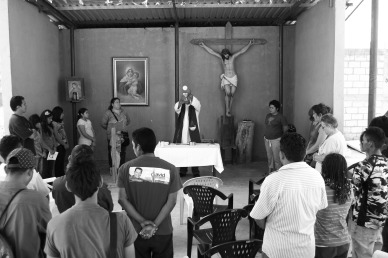 Then there are the deaths. In a small graveyard twenty minutes’ walk from the shelter lie the remains of fifteen migrants. There are no markers, not even any mounds, just flat land covered with weeds. Some of the graves contain one body, some more. The graveyard attendant points out a hole dug for a woman whose body was recently found. No one knows who the dead are or how they died, but it’s clear that some of them, such as the recently discovered woman, were murdered. “These are only the ones we find,” said Hector, who works as a security guard at the shelter. “Others are not found or maybe they are eaten by animals.” It’s anyone’s guess how many migrants die on their way north.
Then there are the deaths. In a small graveyard twenty minutes’ walk from the shelter lie the remains of fifteen migrants. There are no markers, not even any mounds, just flat land covered with weeds. Some of the graves contain one body, some more. The graveyard attendant points out a hole dug for a woman whose body was recently found. No one knows who the dead are or how they died, but it’s clear that some of them, such as the recently discovered woman, were murdered. “These are only the ones we find,” said Hector, who works as a security guard at the shelter. “Others are not found or maybe they are eaten by animals.” It’s anyone’s guess how many migrants die on their way north.
Migrants are attacked by gangs and common criminals, by train crews and villagers, even by the police. Danger comes from every direction. Many have made the trip before and know firsthand how brutal it can be. Those I spoke to said they had no choice: bad as the trip through Mexico is, it’s worth it for the chance to escape to the United States. That’s how bad things are back in their own countries. When I asked migrants if they were afraid, most said they were, but José Luis, a young man from El Salvador, answered matter-of-factly: “We all know we’re going to die. Here or there, it doesn’t matter.”
The tiny village of La Patrona is an eight-hour bus ride from Ixtepec. The village’s name refers to the Virgin of Guadalupe. Like Ixtepec, La Patrona is also an important rail corridor, but here trains rarely slow or stop; most thunder past with migrants clinging to the tops of the cars. It’s here, at a tiny railroad crossing, that a group of women called Las Patronas hand out food and water to migrants passing through town.
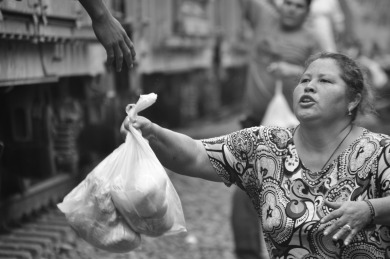
Seventeen years ago, two sisters—Bernarda Romera Vázquez and Rosa Romera Vázquez—were walking past the tracks on their way home after buying some food for breakfast. A train passed by and migrants began calling, “Madre, I’m hungry.” Bernarda and Rosa reflexively tossed them their food. The sisters met with the rest of their family later that day and decided to start handing out food and water to migrants. They’ve been doing it every day since. In the beginning, the women—who aren’t paid and who are poor themselves—donated and cooked all the food in their own houses. Now, much of the food is donated and they cook it in a small kitchen behind a stationery store, a short walk from a railroad crossing. There’s no way for the women to know how many people will be on the next train. They don’t even know when exactly the trains will pass by, or how many of them there will be. Nevertheless, they’re out there to greet each train, because, said Rosa and Bernarda’s sister Norma, “Migrants might go two or three days without food, without water.”
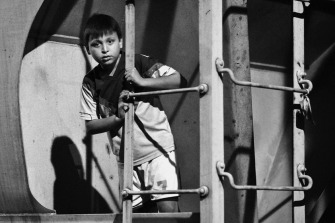 One day, a train stopped at the crossing for about twenty minutes and migrants scrambled down from the cars. The women figured there were about five or six hundred of them. One was José Luís, a frightened-looking eleven-year-old boy from Honduras. He said he was traveling with his brother, but he was all alone on a car toward the back of the train. Nights in southern Mexico are cold, but José Luís was dressed in only a T-shirt, shorts, and sandals. Someone gave him a hooded sweatshirt; others gave him lots of food. “Where are you going?” they asked him. “To the States,” he replied. “Why?” they asked. “There is no work in Honduras,” he said. “Where is your mother?” “She is home.” So José Luís, an eleven-year-old, was heading to the United States to look for work there. It’s hard to imagine the desperation that would make a mother allow her young son to travel over two thousand miles through Mexico, clinging to a train in the hope of making it to the United States.
One day, a train stopped at the crossing for about twenty minutes and migrants scrambled down from the cars. The women figured there were about five or six hundred of them. One was José Luís, a frightened-looking eleven-year-old boy from Honduras. He said he was traveling with his brother, but he was all alone on a car toward the back of the train. Nights in southern Mexico are cold, but José Luís was dressed in only a T-shirt, shorts, and sandals. Someone gave him a hooded sweatshirt; others gave him lots of food. “Where are you going?” they asked him. “To the States,” he replied. “Why?” they asked. “There is no work in Honduras,” he said. “Where is your mother?” “She is home.” So José Luís, an eleven-year-old, was heading to the United States to look for work there. It’s hard to imagine the desperation that would make a mother allow her young son to travel over two thousand miles through Mexico, clinging to a train in the hope of making it to the United States.
Las Patronas have been handing out food for more than seventeen years now and have seen almost everything, but this boy got to them—got to everyone, really. When the day’s work is done, the women always spend some time in the kitchen drinking coffee and talking. There’s usually a lot of laughter and teasing. That night, there were a lot of tears.
Please email comments to [email protected] and join the conversation on our Facebook page.
Share
Previous Story
Christmas Critics
Next Story
Thin Air
